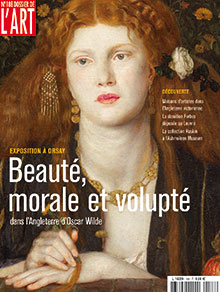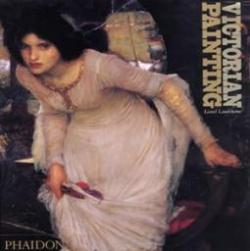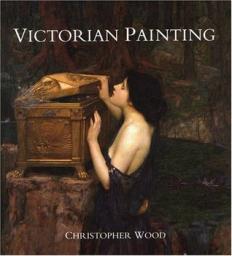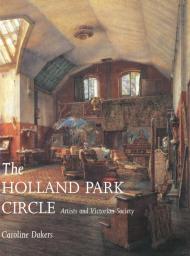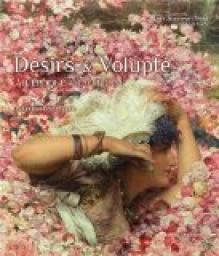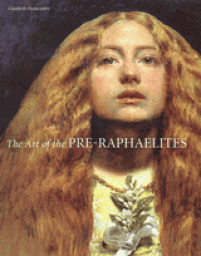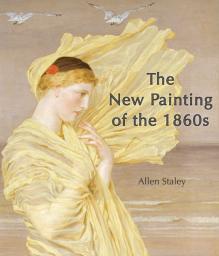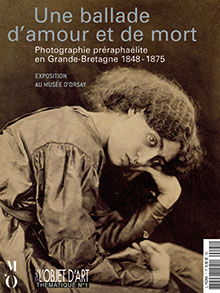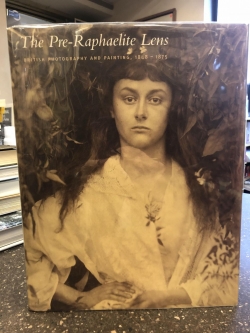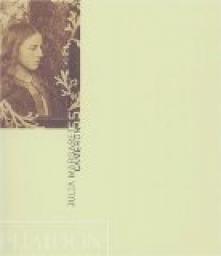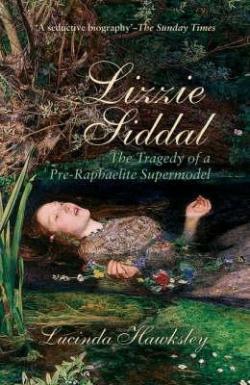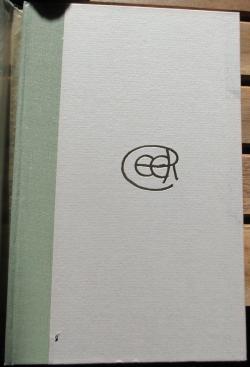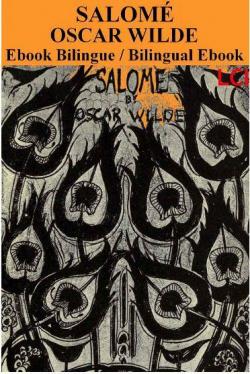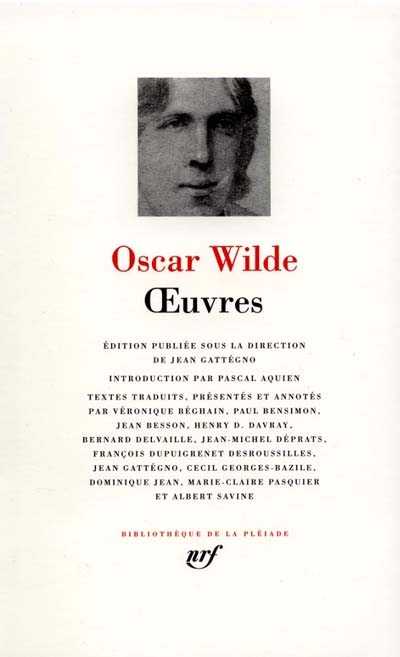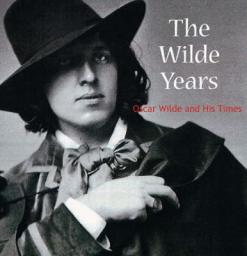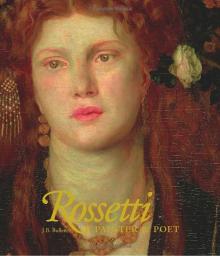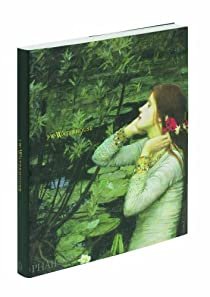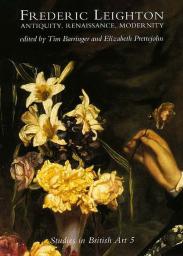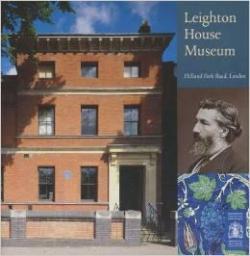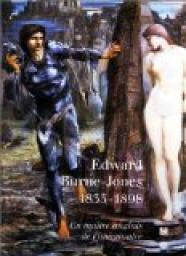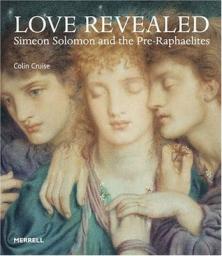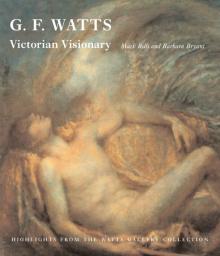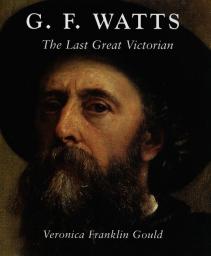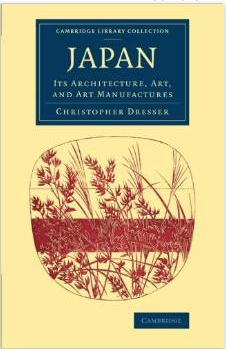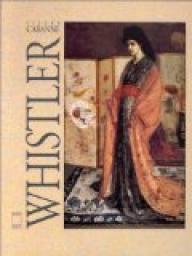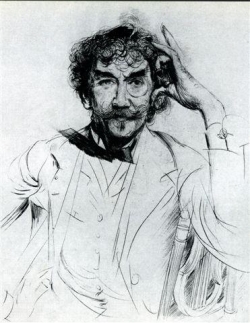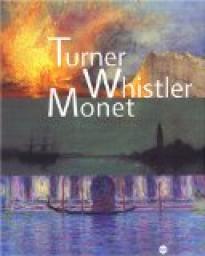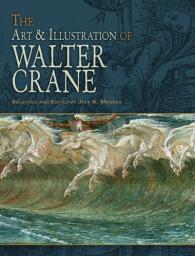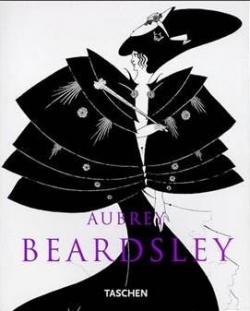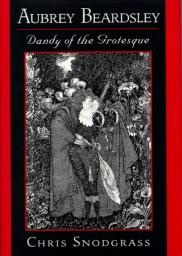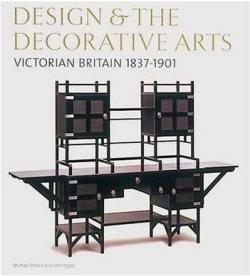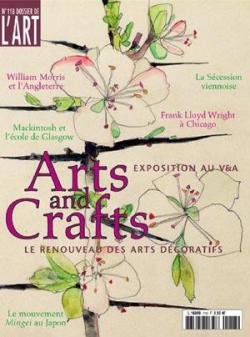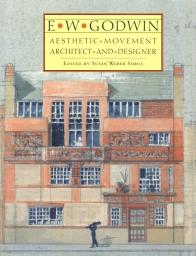
Le culte de la beauté dans l'Angleterre victorienne (1860-1900)
Liste créée par Dossier-de-l-Art le 04/06/2015
65 livres. Thèmes et genres : royaume-uni , victorien , angleterre victorienne , peinture , peinture et littérature
65 livres. Thèmes et genres : royaume-uni , victorien , angleterre victorienne , peinture , peinture et littérature
Le mouvement esthétique, né dans l'Angleterre victorienne, déclinait dans tous les arts, de la peinture à l'architecture, un idéal de beauté.
Si la bibliographie sur le sujet est extensive, elle est encore pour une très large part en anglais. Voici donc, pour les amateurs, une liste bilingue, mettant en valeur les figures majeures de l'époque, peintres, designers, illustrateurs et poètes, des préraphaélites aux représentants des arts & crafts.
1.
Beauté, morale et volupté dans l'Angleterre d'Oscar Wilde
Yves Badetz
Yves Badetz
4.50★
(21)
Ce catalogue a été édité à l'occasion de l'exposition Beauté, morale et volupté dans l'Angleterre d'Oscar Wilde; au musée d'Orsay du 13 septembre 2011 au 15 janvier 2012.
"La beauté a autant de significations que l'homme a d'humeurs. La beauté est le symbole des symboles. Elle révèle tout, parce qu'elle n'exprime rien. Quand elle paraît, elle nous montre le monde entier éclatant de couleurs", Oscar Wilde, 1890. De la confusion des styles et des théories qui agitèrent l'art, la poésie, l'architecture et les arts décoratifs dans l'Angleterre du milieu du XIXe siècle se dégage une même volonté révolutionnaire : échapper à la laideur et au matérialisme de l'époque en créant un nouvel idéal de beauté. Pour Oscar Wilde, Beardsley, Rossetti, Burne-Jones, Morris, Whistler, la beauté devient le mot d'ordre et dicte les codes d'une vie nouvelle où le superflu devient le nécessaire. A travers les plus beaux tableaux de ce mouvement ainsi que ses étonnantes créations dans le domaine de l'ameublement, de la décoration et de la mode, cet ouvrage retrace l'effervescence de l'époque où les artistes, les poètes et leurs muses, les concepteurs d'objets, sans oublier les esthètes et collectionneurs consacrèrent leur vie à la recherche de la beauté.
2.
Dossier de l'art, n°188 : Beauté, morale et volupté
Dossier de l'art
Dossier de l'art
4.50★
(8)
Tableaux, meubles, céramiques, dessins, bijoux... Après le Victoria and Albert Museum, plus de 200 pièces réunies au musée d'Orsay mettent en scène le moment captivant de l'histoire de l'art anglais qui prit tardivement le nom d'Aesthetic Movement. Rassemblant tous les plus grands peintres de l'esthétisme, de Rossetti à Whistler ou Burne-Jones, et les plus illustres créateurs de meubles et d'objets comme Morris, Dresser et Godwin, l'exposition évoque avec faste cette aventure esthétique qui eut la beauté pour seul horizon, et fut le miroir des désirs, des contradictions, de l'esprit d'une époque. Entretien avec Yves Badetz, conservateur au musée d'Orsay, commissaire de l'exposition.
Dossier : Autour de 1855-1860 émerge dans l'Angleterre victorienne, au cœur des cercles où se côtoient artistes, écrivains et critiques, une singulière vision esthétique qui fait de la beauté pure le but ultime de l'art, et qui va prendre l'ampleur d'une mode, bouleversant le cadre de vie de l'aristocratie et de la classe moyenne. Délaissant tout sujet, la peinture se fait symphonie de couleurs et de formes, tandis que l'injonction de vivre au milieu des belles choses impose les arts décoratifs dans les intérieurs et conduit les plus brillants créateurs à préfigurer le design moderne.
3.
The Aesthetic Movement
Lionel Lambourne
Lionel Lambourne
The Aesthetic Movement swept through England in the latter part of the nineteenth century, touching every sphere of the fine and decorative arts and bringing a new freedom to all aspects of design.
In architecture, the dogmatism of Gothic gave way to the charm of Queen Anne. In interiors, heavy Victorian forms were replaced by the lighter, fresher Japanese-inspired shapes; in the graphic arts, innovative methods - coupled with a new approach to form - led to the revitalization of illustration and book design.
Personified by such colourful figures as James McNeill Whistler, Oscar Wilde and Aubrey Beardsley, the movement was held together by the coherence of its philosophy and its adamant faith in elegance and richness. This beautiful and witty book will prove invaluable to enthusiasts of design and architecture and to all those intrigued by the social history of the period.
4.
The age of Rossetti, Burne-Jones & Watts : Symbolism in Britain, 1860-1910
Andrew Wilton
Andrew Wilton
In the last twenty-five years Symbolism has been much investigated, but British artists have usually been accorded a marginal role in the movement. It has always been assumed that Symbolism was essentially a continental phenomenon, having only slight links with what happened in Great Britain in the late nineteenth century. This new examination of the subject revises that view by focusing on key British artists, some of whom predate their continental colleagues in dealing with the characteristic themes of Symbolism. These were, above all, Death, Sleep, and the erotic impulse. Sometimes the Europeans were a decade or more behind their British counterparts, who provided important precedents for this innovations. It has been overlooked that both Watts and Burne-Jones exhibited in Paris to critical acclaim, that the young Picasso admired Burne-Jones, and that the leading Belgian Symbolist, Fernand Khnopff, wrote articles for the London art magazine The Studio. There was in fact a far greater exchange of ideas between British and continental artists than might at first be imagined.
Published to accompany the major exhibition at the Tate Gallery, this catalogue examines some central themes of Symbolist art, and includes important works by Rossetti, Burne-Jones, Watts, Whistler, Beardsley, Moreau and Khnopff. All the works in the show--over one hundred and thirty paintings, drawings and sculpture--are reproduced in colour. With an introduction by Andrew Wilton, Keeper of the British Collection at the Tate Gallery, the catalogue also includes essays by leading scholars in the field: Barbara Bryant, Christopher Newall, Mary Anne Stevens and Robert Upstone. The contributors have also written the detailed catalogue entries for this fascinating and often revelatory book.
5.
Victorian Painting
Lionel Lambourne
Lionel Lambourne
Victorian Painting is a comprehensive survey of one of the most fertile and varied Bras in the history of painting. It embraces not just the United Kingdom but also the English-speaking countries linked to Britain by cultural ties of emigration and empire, such as the United States, Canada, Australia, New Zealand and Africa. Long regarded as a backwater of sentiment and outmoded academic convention, Victorian painting is now wholeheartedly in its owns. Unfettered by old prejudices, Lionel Lainbourne presents a vivid panorama of an age of unparalleled energy and creativity. Wealth, optimism, education and self-confidence created a huge demand for art, and a formidable array of original and lightly talented artists emerged to meet it. Producing works in a wide range of styles, subjects and media, many painters became celebrities, while the profession as a whole enjoyed unprecedented public esteem. The author tackles this protean subject by dividing it into themes which reflect its richness and variety. After the Introduction and an illuminating survey of the Victorian Art Establishment, long chapters are devoted to the major subjects of Mural fainting, Portraiture, Landscape and Genre, while further chapters deal with particular themes: Sporting and Animal Painting, Fairy fainting, Childhood, the Panorama, Cross-Sections of Society, Social Realism, Emigration and the Nude. The author also focuses on Women Artists and on the troubled relations between the sexes; on movement such as the Pre-Raphaelites, the Aesthetes and Symbolists, and the British Impressionists; and on painting in the United States and the British colonies. Written with a light touch, full of well-chosen and amusing anecdotes, and with over 600 colour illustrations, Victorian Painting is beautiful, entertaining and informative. It is also a valuable reference work, for in addition to many famous and well-loved images, it presents a wealth of fine work by lesser-known artists, and explores the byways as well as the highways of Victorian art. Taking a generous view of the subject and sharing his enthusiasm with the reader, Lionel Lainbourne captures the vitality and exuberance of a remarkable age.
6.
Victorian Paintings
Christopher Wood (II)
Christopher Wood (II)
The Victorian era and its aftermath were the backdrop to one of the great flowerings of British art. The genre arose from a ferment of activity from which the Pre-Raphaelites emerged along with Leighton's luxurious classical mythologies, as well as a fascinating diversity in other artistic fields. Christopher Wood, a leading expert who has not only studied but also bought, owned, and sold examples of everything he writes about, takes us through the artistry of Burne-Jones, Rossetti, Waterhouse, and others to show the succession of movements characterizing the Victorian period.
7.
The Grosvenor Gallery. A Palace of Art in Victorian England
Susan P. Casteras
Susan P. Casteras
London's notorious Grosvenor Gallery was founded by Sir Coutts Lindsay and his wife, Lady Blanche Lindsay, to serve as an alternative to the Royal Academy. Although it existed only from 1877 to 1890, the gallery displayed the works and advanced the careers of many progressive artists, particularly those whose work was ignored by the traditional tastes of the usual exhibition venues. The Lindsays' innovative approach to art, audiences, and exhibition display made the gallery an influential force not only in Victorian art and society but also in the evolution of modern-day museum practice.
This first in-depth study of the Grosvenor Gallery consists of essays by noted scholars in nineteenth-century art and culture who explore critical aspects of the gallery such as the significance of its social ambience, the diverse content of its winter and summer exhibitions, and its status in the context of other exhibition sites. The authors also consider artists and groups who exhibited at the gallery, including Edward Burne-Jones and the second generation Pre-Raphaelites, James McNeill Whistler, George Frederic Watts, Evelyn Pickering De Morgan and other women artists, the Newlyn School, British Rustic Naturalists, and the Glasgow Boys.
8.
Art for Art's Sake. Aestheticism in Victorian Painting
Elizabeth Prettejohn
Elizabeth Prettejohn
In the London circles of Dante Gabriel Rossetti and Frederic Leighton, the notion of “art for art's sake” became a shared concern: if art is not created for the sake of preaching a moral lesson, or supporting a political cause, or making a fortune, or any other objective, what might art be? Art historian Elizabeth Prettejohn traces the emergence of the debates over this issue in the 1860s and 1870s, focusing especially on the Rossetti, Whistler, Leighton, and other protagonists of the Aesthetic Movement and their paintings—some of the most haunting and memorable images in modern art. The English painters' search for the formula to best express the idea of “art for art's sake” was a unified and powerful artistic undertaking, Prettejohn demonstrates, and the Aesthetic Movement made important contributions to the history of modern art.
9.
The Holland Park Circle. Artists and Victorian Society
Caroline Dakers
Caroline Dakers
The reign of Queen Victoria witnessed a spectacular rise in the visibility, wealth, and prestige of English artists and designers. Leading this resurgence was a group of artists who established their studios in and around the new, fashionable district of London’s Holland Park. This book—the first major study of the Holland Park Circle of artists, architects, and their patrons—is both an engrossing narrative of their lives, works, and influence and a perceptive analysis of the subtle relationships between high Victorian taste and mercantile values.
The circle was formed around G. F. Watts, who lived at Little Holland House; the handsome and accomplished Frederic Leighton; and their friend Valentine Prinsep. The artists who followed included Luke Fildes, Hamo Thornycroft, William Burges, Marcus Stone, James Jebusa Shannon, and Holman Hunt. Their studio-houses, designed by prominent architects of the era, were featured in architectural journals and society magazines, influencing the external and internal appearance of London’s buildings. Caroline Dakers also describes how the artists posed "at home" for society photographs and how their "Show Sundays," when the public was invited into the studios, became part of the London Season. She presents a fresh perspective on a period when art in England, in the words of Henry James, had become "a great fashion."
10.
Désirs et volupté à l'époque victorienne : Collection Pérez Simon
Véronique Gérard-Powell
Véronique Gérard-Powell
5.00★
(18)
A l'heure où la peinture victorienne jouit d'un nouvel engouement dans les musées et auprès des collectionneurs, le Musée Jacquemart-André a lui aussi choisi de mettre à l'honneur les grands artistes de cette période, comme Lawrence Alma-Tadema (1836-1912), Frederic Leighton (1830-1896), Edward Coley Burne-Jones (1833-1898), Albert Joseph Moore (1841-1893) ou John William Waterhouse (1849-1917). Ces peintres ont en commun de célébrer la beauté féminine, comme en témoignent la cinquantaine d'oeuvres réunies pour l'exposition. Offrant un large aperçu de la peinture britannique des années 1860 à la veille de la Première Guerre mondiale, elles proviennent toutes de la collection de Juan Antonio Perez Simon, qui réunit l'un des plus beaux ensembles d'art victorien en mains privées. Naviguant entre Antiquité réinventée, légendes médiévales et décors au charme tout britannique, les grands artistes de cette époque puisent à de multiples sources d'inspiration. Sous leurs pinceaux, la femme se transforme en héroïne antique ou shakespearienne, prenant tour à tour les traits d'une muse, d'une enchanteresse ou d'une amoureuse mélancolique. A travers ses mille visages, elle incarne tous les rêves victoriens.
11.
Les préraphaélites : De Rossetti à Burne-Jones
Guillaume Morel (II)
Guillaume Morel (II)
4.40★
(24)
En 1848, trois étudiants rebelles de la Royal Academy, à Londres, créent la confrérie préraphaélite et imposent un nouveau style basé sur l'observation directe de la nature. Ils aspirent à révolutionner la peinture anglaise en retrouvant une simplicité et une vérité qu'ils estiment perdues depuis Raphaël, à travers un art de lumière et de couleurs vives, de poésie et de séduction. En six chapitres thématiques, l'art religieux, la littérature et la mythologie, le paysage, la vie quotidienne, le portrait, les arts décoratifs, ce livre dévoile les incontournables et les oeuvres plus secrètes d'artistes comme John William Hunt, John Everett Millais, Dante Gabriel Rossetti, EdwardBurne-Jones, William Morris ou Lawrence Alma-Tadema. Un hymne à la beauté, à la nature et à la sensualité.
12.
The Art of the Pre-Raphaelites
Elizabeth Prettejohn
Elizabeth Prettejohn
4.00★
(2)
In 1848 seven inexperienced young artists banded together to form the Pre-Raphaelite Brotherhood. Together they created a novel style that bewildered its first audiences and retains the power to shock, as well as fascinate, a century and a half later. This book explores the collaborative practices of the Brothers and their close associates, and accords a major role to the women artists of the Pre-Raphaelite circle. By working together, the Pre-Raphaelites constituted one of the first and most distinctive group movements in modern art, comparable to the Impressionists and later movements in France. This lavishly illustrated book concentrates more closely on the visual impact of Pre-Raphaelite art than any previous study. The materials, techniques, and working practices of the artists are analysed, using many close-up details, to ask how Pre-Raphaelite pictures compel the viewer to see more, and more vividly, than traditional painting styles. This intensity of observation reinforces the distinctive subject matter of the pictures: the natural world and the human model, gender identities and sexual relationships, debates on politics, science, and religion. The first publication on this scale since the Tate Pre-Raphaelite catalogue of 1984, The Art of the Pre-Raphaelites incorporates the rapidly expanding research of recent years to produce a new assessment of the movements importance in modern art.
13.
The New Painting of the 1860s. Between the Pre-Raphaelites and the Aesthetic Movement
Allen Staley
Allen Staley
This handsome volume is the first authoritative survey of one of the most intriguing periods of British art—the radically innovative decade of the 1860s. The book explores new developments in English painting of this period, focusing on the early work of Edward Burne-Jones, Frederic Leighton, Albert Moore, Edward Poynter, Simeon Solomon, and James McNeill Whistler, as well as on paintings by Frederick Sandys and the older G. F. Watts, and by Dante Gabriel Rossetti and his Pre-Raphaelite colleagues Holman Hunt and John Everett Millais.
Allen Staley argues that engagement in the decorative arts, particularly by Burne-Jones, Moore, and Poynter at the outset of their careers, led to a transcending of traditional expectations of painting, making abstract formal qualities, or beauty for beauty's sake, the main goal. Rather than being about what it depicts, the painting itself becomes its own subject. The New Painting of the 1860s examines the interplay among the artists and the shared ambitions underlying their works, giving impetus to what would soon come to be known as the Aesthetic Movement.
14.
Yvain ou le Chevalier au Lion - Lancelot ou le Chevalier de la Charette
Chrétien de Troyes
Chrétien de Troyes
4.31★
(58)
Composés à la fin du XIIe siècle, Yvain et Lancelot sont les deux oeuvres emblématiques de Chrétien de Troyes. Au fil d'aventures inspirées de la légende arthurienne, les héros de la Table Ronde doivent maintenir le délicat équilibre entre amour courtois et prouesses chevaleresques. Les peintres préraphaélites, notamment Dante Gabriel Rossetti, Edward Burne-Jones ou William Morris, réalisent à la fin du XIXe siècle des oeuvres dont l'intensité, l'émotion et la grâce illustrent admirablement les scènes intimes et épiques des romans de Chrétien de Troyes. C'est l'occasion de redécouvrir au fil d'une promenade enchanteresse deux époques, deux univers unis dans une même quête de valeurs, de beauté et de spiritualité. La recherche de la pureté et de l'émotion, la prééminence du désir et du coeur, la création d'un imaginaire merveilleux et poétique unit Chrétien de Troyes et les préraphaélites au-delà des siècles. Une incarnation intense et poétique des héros mythiques de la légende arthurienne par les peintres préraphaélites. Une iconographie puissante, habitée par le souffle du mythe arthurien, restitue ici toute l'énergie des romans de Chrétien de Troyes, loin de l'inertie des enluminures médiévales. Deux romans d'amour et d'armes, présentés dans une nouvelle mise en page, plus aérée, pour un plus grand plaisir de lecture. Des personnages indémodables : la légende arthurienne inspire tous les arts et tous les âges : de Thomas Malory au XVe siècle au film Lancelot avec Sean Connery, la série télévisée Kaamelot, les Monty Python ou le Merlin de Walt Disney. Au-delà de leur beauté esthétique, le texte et les oeuvres picturales sont emplies de symboles et d'allégories. La contribution de spécialistes reconnus, Philippe Walter et Laurence des Cars, nous éclaire et nous guide pour une lecture multiple de ces chefs d'oeuvres.
15.
L'Objet d'Art thématique 1. Une ballade d'amour et de mort. Photographie préraphaélite en Grande-Bretagne, 1848-1875
L'Objet d'Art
L'Objet d'Art
3.50★
(11)
Cette exposition, qui ouvre à Paris au musée d'Orsay du 8 mars au 29 mai 2011, est la première étude en profondeur consacrée aux relations étroites entre photographie victorienne et peinture préraphaélite. Elle a été conçue par Diane Waggoner, assistant conservateur à la National Gallery de Washington, où l'exposition a été présentée du 31 octobre 2010 au 30 janvier 2011 sous le titre Pre-raphaelite Lens. British photography and painting, 1848-1875.
16.
The Pre-Raphaelite Lens: British Photography and Painting, 1848-1875
Diane Waggoner
Diane Waggoner
As photography steadily gained a foothold in the 1840s, a group of British painters calling themselves the Pre-Raphaelites came of age. Answering John Ruskin's call to study nature, "rejecting nothing, selecting nothing, and scorning nothing," these young painters were also spurred on by the possibilities of the new medium (introduced in 1839), particularly its ability to capture every nuance, every detail. And yet, the Pre-Raphaelites' debt to photography has barely been acknowledged. From photography, painters learned to see anew: adapting such radical qualities as abrupt cropping, planar recession, and a lack of modulation between forms, painters made their art modern, sometimes shockingly so.
Photographers in turn looked to Pre-Raphaelite visual strategies and subject matter - mined from literature, history, religion—to secure, as Julia Margaret Cameron wrote, "the character and uses of High Art." These artists developed a shared vocabulary—featuring light and minute detail as an emblem of visual truth—which helped launch realism as the century's dominant visual mode. "Exactness," a critic affirmed in 1856, "is the tendency of the age."
This volume explores the rich dialogue between photography and painting through the themes of landscape, portraiture, literary and historical narratives and modern-life subjects. These artists—from photographers Lewis Carroll, Julia Margaret Cameron, Roger Fenton, Henry Peach Robinson and Oscar Gustave Rejlander, to such painters as John Everett Millais, William Holman Hunt, Dante Gabriel Rossetti and John William Inchbold—not only had much in common, but also upended traditional approaches to making pictures.
17.
Julia Margaret Cameron
Julia Margaret Cameron
Julia Margaret Cameron
4.43★
(16)
En 1863, alors qu'elle est une femme d'âge mûr, Julia Margaret Cameron s'initie à la photographie. Avec autant de passion que de détermination. Le poulailler est transformé en studio, la cave à charbon en chambre noire. D'abord moquée par une critique qu'on peut soupçonner de misogynie, elle développe une pratique photographique bien éloignée des préoccupations de perfectionnement technique et de réalisme documentaire de ses contemporains.
En effet, ses aspirations artistiques et picturales la conduisent à produire des portraits de grand format, des scènes bibliques comme des scènes de genre. Auteur prolixe, elle utilise comme modèle le cercle d'artistes et d'intellectuels qui l'entourent comme ses proches ou sa femme de chambre.
Femme émancipée, elle fait de sa passion pour la photographie une activité professionnelle, exposant et commercialisant ses tirages. Photographe précurseur, par son soucis constant de la maîtrise de la lumière et du flou, par l'intensité émotionnelle de ses portraits, Julia Margaret Cameron suscite, dès le début du vingtième siècle, l'admiration d'Alvin Langdon Coburn ou d'Alfret Stieglitz, et inspire très largement le mouvement pictoraliste.
18.
Julia Margaret Cameron
Joanne Lukitsh
Joanne Lukitsh
3.58★
(13)
Julia Margaret Cameron (1815-1879) a presque cinquante ans - et est autodidacte - lorsqu'elle se met à la photographie ; néanmoins, les portraits qu'elle réalise comptent parmi les plus innovants et les plus marquants de l'époque. Son utilisation inédite de la lumière et de la mise au point transforme l'art du portrait et contribue à faire de la photographie un art expressif.
19.
Victorian Photography, Painting and Poetry: The Enigma of Visibility in Ruskin, Morris and the Pre-Raphaelites
Lindsay Smith
Lindsay Smith
This book explores the intersections between Victorian literature, painting and photography. Taking as a starting point mid-nineteenth-century developments in the understanding of visual perception, Lindsay Smith examines the representation of a pervasive desire for a literal understanding of the process of seeing and perceiving. This is played out in the aesthetic theory of John Ruskin, the early poetry of William Morris, paintings of the Pre-Raphaelites, and in the photographic technique of combination printing. She demonstrates how the novel presence of the camera in nineteenth-century culture not only transforms acts of looking, but also affects major social, aesthetic and philosophical categories. By exploring the intricacies of photographic discourse she shows how Ruskin and Morris produce a critique of the earlier Cartesian perspectival model of vision.
20.
Lizzie Siddal. The Tragedy of a Pre-Raphaelite Supermodel
Lucinda Hawksley
Lucinda Hawksley
4.00★
(4)
Lizzie Siddal Saved from the drudgery of a working-class existence by an astute young Pre-Raphaelite artist, Lizzie Siddal rose to become one of the most famous faces in Victorian Britain, until tragically ending her young life in 1862. This biography takes Lizzie from the background of Dante Gabriel Rossetti's life and brings her to the forefront of her own.
21.
Poems and Drawings of Elizabeth Siddal
Roger C. Lewis
Roger C. Lewis
5.00★
(2)
Très rare (500 exemplaires numérotés) édition de l'ensemble des poèmes d'Elizabeth Siddal, accompagnés d'une sélection de ses oeuvres picturales présentée dans un cahier central en couleurs.
22.
Etrangete, passion, couleur. L'hellénisme de Swinburne, Pater et Symonds (1865-1880)
Charlotte Ribeyrol
Charlotte Ribeyrol
L'hellénisme naît dans le sillage romantique de l'oeuvre de J. J. Winckelmann dont la vision épurée de l'Antiquité continue de nourrir les fantasmes helléniques de nombreux auteurs anglais tout au long du XIXe siècle. Mais dans les années 1860-1880 un tournant se fait jour dans l'hellénomanie victorienne grâce à l'émergence de sciences telles que l'archéologie et l'anthropologie. En écho à ces recherches nouvelles qui jettent un éclairage autre sur l'antique, A. C. Swinburne, W. Pater et J. A. Symonds, trois auteurs appartenant au mouvement esthétique («Aestheticism»), se mettent en quête des parts d'ombre de l'Hellade, de son altérité et de ses couleurs, autant de marges dionysiaques qui viennent nuancer les fantasmes apolliniens de leurs contemporains. Substituant au désir d'érudition philologique une volonté d'exhumation des aspects les plus secrets de la culture grecque, ces poètes et essayistes révèlent ainsi une part trouble de l'héritage hellénique qui se donne également à voir dans les tableaux des peintres de leur cercle proche, comme E. Burne-Jones, S. Solomon, J. McNeill Whistler, A. Moore et D. G. Rossetti.
23.
Poèmes choisis
Algernon Charles Swinburne
Algernon Charles Swinburne
3.67★
(6)
C’est à un scandale que Swinburne doit sa réputation : celui de la publication en 1866 de Poèmes et Ballades, dont les censeurs victoriens se plurent à exagérer, et partant, à dénoncer, le paganisme, les excès blasphématoires et les débordements érotico-pervers : “la critique se fâcha ”, remarqua Maupassant, “la critique anglaise, étroite, haineuse dans sa pudeur de vieille méthodiste qui veut des jupes à la nudité des images et des vers, comme on en pourrait vouloir aux jambes de bois des chaises”. À cet date, Swinburne était un poète déjà célèbre mais l’esprit et la lettre de Poèmes et Ballades devaient, jusqu’à la fin de sa carrière poétique et même au-delà, associer le nom de Swinburne au décadentisme esthétique et chatoyant en vogue dans la seconde moitié du dix-neuvième siècle.
La volupté, en tant que thème, occupe une place privilégiée chez Swinburne, en particulier, mais pas exclusivement, dans les premiers Poèmes et Ballades. Elle apparaît soit sous la forme d’un fantasme sado-masochiste, soit sous celle d’un désir étourdissant de fusion et d’anéantissement de l’être. Dans tous les cas, la mort règne. L’image de la femme par ailleurs n’échappe pas aux stéréotypes du décadentisme : elle est, avant tout, une créature fascinante et inquiétante.
Extrait de la préface de Pascal Aquien.
24.
Tombeau de Swinburne
Denis Bonnecase
Denis Bonnecase
Algernon Charles Swinburne est né en 1937 à Londres et mort en 1909. C'est un devoir de mémoire que d'honorer l'oeuvre de ce grand poète francophile qui plaçait Hugo, Balzac et Baudelaire au faîte du panthéon de la littérature. Héritier des Romantiques anglais, Swinburne est le maillon qui fait passer la poésie britannique dans la modernité. Souvent blasphémateur et provocateur par son comportement en ses jeunes années, il persista à faire oeuvre de transgression tout au long de sa vie par son maniement de la forme poétique et l'exploration décisive des ressources du signifiant. Il n'eut de cesse, en effet, de s'acheminer vers ce que l'on ne peut qu'appeler l'expression totale du verbe: faire parler et, surtout, chanter le désir, trouver les formes disant le corps aussi bien que la pensée et l'émotion, telle fut l'intention de Swinburne et la signification profonde de ses audaces créatrices si peu comprises par ses contemporains. Il s'agissait pour lui de toucher cette pointe extrême de l'intensité poétique faisant sentir à son lecteur la sublimité de l'être humain dans son rapport à la langue. Les textes de ce recueil non seulement offrent une vue cohérente des aspects principaux de son oeuvre abondante, mais ils s'attachent aussi à faire sentir cette constante de son écriture. Les traductions inédites à la fin de l'ouvrage contribuent à faire redécouvrir aux lecteurs la pertinence de sa vision critique et l'étrange beauté de sa vision poétique.
25.
Essais sur l'art de la Renaissance
Walter Pater
Walter Pater
3.00★
(9)
Quand il a offert à ses contemporains en 1873 La Renaissance, ce bréviaire impertinent et poétique qui leur enseignait le plaisir esthétique, Walter Pater désirait éclairer en termes discrètement révolutionnaires la relation fondamentale qui unit le " regardeur " à l'œuvre d'art : une satisfaction de tout l'être. Affaire de sensualité et non d'intellect, produit d'obsessions autrement inexprimables et non d'un idéal, l'art ne fait-il pas affleurer dans le sensible les forces profondes qui animent l'homme dans une indistinction troublante, au-delà du bien et du mal ? Dans ces pages qui démontrent une audacieuse modernité, Walter Pater commente tour à tour La Joconde, La Naissance de Vénus, Le Concert champêtre ou telle statue grecque.
26.
Salomé
Oscar Wilde
Oscar Wilde
3.81★
(785)
A la fin du XIXe siècle, le mythe de Salomé suscite chez les artistes une fascination à nulle autre pareille : la princesse de Judée, qui incarne la femme " naturelle, c'est-à-dire abominable " selon le mot de Baudelaire, devient une figure majeure de l'imaginaire décadent, inspirant indifféremment peintres, poètes et romanciers.
De cette danseuse fatale, Wilde donna dans Salomé (1893) l'une des interprétations les plus marquantes de l'histoire de la littérature. La tension croissante de ce drame en un acte traduit la montée du désir monstrueux de Salomé, la fille d'Hérodias, pour le prophète Iokanaan.
Cruauté, sacrilège, étrangeté et érotisme se mêlent dans cette pièce dont Mallarmé salua les perpétuels traits éblouissants et dont Pierre Loti a pu dire : " C'est beau et sombre comme un chapitre de l'Apocalypse."
28.
The Wilde Years: Oscar Wilde and His Times
Tomoko Sato
Tomoko Sato
This study of Oscar Wilde presents him as the central, catalytic figure who linked together the artistic cities of London and Paris in the last quarter of the nineteenth century. The book discusses Wilde's many talents and looks at the contribution he made to the artistic and cultural movements of his age. The text also covers the other aspects of Wilde's work for which he was less well known, these include his work as an art critic, journalist and progressive political thinker. The book is an accompaniment to an exhibition at the Barbican Art Gallery which commemorates the centenary of Wilde's death.
29.
Méduse au miroir : Esthétique romantique de Dante Gabriel Rossetti
Laurence Roussillon-Constanty
Laurence Roussillon-Constanty
On connaît bien la silhouette des femmes peintes par Dante Gabriel Rossetti, l'un des peintres majeurs du mouvement préraphaélite anglais : mâchoire carrée, cascade de cheveux longs bouclés, teint diaphane… Mais on connaît moins les poèmes composés en regard de ses tableaux ou même écrits directement sur la toile. Poèmes fleuves ou sonnets, ces écrits parlent d'amour éternel et pourtant éphémère, d'une femme idéale rêvée plus que contemplée, d'une amoureuse fatale tout à la fois vénérée et redoutée. Au coeur de l'Angleterre victorienne, l'Anglo-Italien Rossetti serait un nouveau Dante, ou un antique héros à l'image de Persée, qui, pour gagner la main d'Andromède, dut s'emparer de la tête de Méduse, emblème d'une féminité effrayante et dangereuse.
Dans ce livre, l'auteur nous invite à retracer le parcours unique d'un des rares auteurs anglais à avoir été à la fois peintre et poète.
30.
Rossetti: Painter and Poet
J.B. Bullen
J.B. Bullen
Rossetti, painter and poet is a critical biography of Dante Gabriel Rossetti that examines the relationship between his art and his writing in the context of his life. Bullen’s premise is that Rossetti was a courageous pioneer in the late-nineteenth-century world of evasion and repression. He dared to explore the hidden recesses of the mind and to claim that the libido was a driving force in human life. Both Rossetti’s art and his poetry were castigated for their ‘fleshliness’ but Bullen maintains that in his painting and in his poetry Rossetti’s focus on the erotic life was a way of asserting the centrality of the sexual drive. His subject was the female psyche and the female body, and pictures that for so long were dismissed as merely decorative and repetitive are in fact part of a project on Rossetti’s part to explore what was considered to be the dark side of life. Illustrated with 250 plates mostly in colour, this book presents a new account of the life and work of perhaps the most vibrant figure in nineteenth century art.
31.
J-W Waterhouse
Peter Trippi
Peter Trippi
4.46★
(33)
John-William Waterhouse (1849-1917) figure parmi les artistes victoriens les plus appréciés, et nombre de ses tableaux sont devenus des représentations emblématiques de la féminité à travers le monde.
Avec leurs couleurs éclatantes, leur composition fascinante et leur technique influencée par l'impressionnisme, ces ?uvres suscitent l'admiration en même temps qu'elles transportent le spectateur dans un monde romantique de mythes et de légendes. L'art de Waterhouse reflète non seulement un idéal précis de beauté féminine mais aussi une fascination récurrente pour les thèmes romantiques et symbolistes de la passion, de la magie et de la métamorphose, spirituelle, érotique ou physique.
Ces thèmes traduisent également les attitudes complexes et ambiguës de toute une époque. Peter Trippi présente une analyse inédite de l'univers de Waterhouse, avec ses enchanteresses, ses martyres et ses nymphes, à travers une étude approfondie de sa vie, aussi surprenante qu'énigmatique, et du contexte de travail du peintre. Comme d'autres artistes de l'époque victorienne, Waterhouse fut délaissé durant la majeure partie du XXe siècle.
Aujourd'hui, son importance en tant que principal dépositaire de l'héritage préraphaélite est enfin reconnue. Cette monographie offre une réévaluation de son art, associant à une lecture précise de l'imagerie de Waterhouse un nouvel éloge de son talent unique et intemporel.
32.
J.W. Waterhouse (1849-1917)
Elizabeth Prettejohn
Elizabeth Prettejohn
4.00★
(2)
Cet aperçu innovant présente l'œuvre de John William Waterhouse (1849-1917), un des artistes britanniques les plus appréciés du XIXe siècle. Le livre est amplement illustré de reproductions magnifiques qui rendent pleinement justice à l'effet visuel des toiles colorées et séduisantes de Waterhouse, et explorent sa vision intemporelle de la féminité. Dans son œuvre, un rôle particulier est réservé aux passions intenses des mythes classiques d'Homère et Ovide, tels qu'ils ont été interprétés par les vers romantiques d'Alfred Tennyson et de John Keats, et par leur prédécesseur William Shakespeare. On devine à quel point Waterhouse s'est senti proche de ces poètes par ses superbes œuvres telles que La Dame de Shalott, Sainte Cécile, Hylas et les nymphes, Ulysse et les sirènes, Circé Invidiosa et Echo et Narcisse. Bien que des millions de gens dans le monde entier aient admiré ses tableaux éblouissants, le grand public sait relativement peu de choses sur la personne de Waterhouse. Dans ce livre, il se révèle comme un " préraphaélite moderne", imprégné qu'il était de l'émotivité colorée de Rossetti, Millais et Holman Hunt, mais aussi entièrement pénétré par les innovations techniques captivantes qui surviennent en France à la fin du XIXe siècle. Avec cette édition magnifique, les œuvres célèbres de Waterhouse sont mises dans leur juste contexte pour illustrer leur grande signification dans l'histoire de l'art britannique.
33.
John Everett Millais
Jason Rosenfeld
Jason Rosenfeld
John Everett Millais (1829–1896) was one of the most significant English painters of the nineteenth century, successful and respected during his career, honoured as the first painter to be created a baronet, he remains, as recent exhibitions of his work have demonstrated, equally well known today.
Whilst his substantial contributions are rarely, if ever, denied, in past art historical accounts of Millais’s long career there has been an unfortunate tendency to superficially distinguish between the early promise of his Pre-Raphaelite masterpieces and the perceived commercial and traditionalist orientation of his later works.
In this new study of the artist’s life and work Rosenfeld argues that such readings are far from accurate, demonstrating that the development of Millais’s art was at the forefront of contemporary painting throughout his life. At the same time as Manet and Monet were liberating their nation’s art from traditional forms and subjects, Millais was leading British art with the bravura manner and looser symbolic associations of Aestheticism (the most important movement after Pre-Raphaelitism), which in turn influenced the portraits of John Singer Sargent and the landscapes of Vincent Van Gogh. In Rosenfeld’s words, it is a ‘consistently relevant and inventive Millais’ that emerges in this book.
34.
Frederic Leighton - Antiquities, Renaissance, Modernity
Tim Barringer
Tim Barringer
Liberated from the constraints of tradition, the Pre-Raphaelites of mid-Victorian England produced distinctive representations of nature and society in paintings remarkable for their compositional vitality and hallucinatory effects of color. This lavishly illustrated book provides a fresh appraisal of the Pre-Raphaelite artists and their radical departure from artistic conventions. Tim Barringer explores the meanings so richly encoded in Pre-Raphaelite paintings and analyzes key pictures and their significance within the complex social and cultural matrix of nineteenth-century Britain. In chapters devoted to core themes, the author discusses such artists as John Everett Millais, William Holman Hunt, Dante Gabriel Rossetti, and Ford Madox Brown and their engagement with medieval revivalism, nature worship, issues of class and gender, and the reconciliation of the religious image and realism.
Barringer draws on an imaginative selection of paintings, drawings, and contemporary photographs to suggest that the dynamic energy of Pre-Raphael-ism arose from paradoxes at its heart. Past and present, historicism and modernity, symbolism and realism, as well as tensions between city and country, man and woman, worker and capitalist, colonizer and colonized—all appear within Pre-Raphaelite art. Focusing on these issues, the author casts new light on the Pre-Raphaelites and their innovative work.
35.
Leighton House Museum: Holland Park Road, Kensington
Daniel Robbins
Daniel Robbins
Leighton House Museum is the former home of the Victorian artist Frederic, Lord Leighton (1830-1896). The only purpose-built studio-house open to the public in the United Kingdom, it is one of the most remarkable buildings of the nineteenth century, containing a fascinating collection of paintings and sculpture by Leighton and his contemporaries.
Built to Leighton’s precise requirements, the house was extended and embellished over the 30 years that he lived in it. From modest beginnings it grew into a ‘private palace of art’ featuring the extraordinary Arab Hall with its golden dome, intricate mosaics and walls lined with beautiful Islamic tiles. Upstairs, Leighton’s vast painting studio was one of the sights of London, filled with paintings in different stages of completion, the walls hung with examples of his work and lit by a great north window. Many of the most prominent figures of the Victorian age were entertained in this room; including Queen Victoria herself who called on Leighton in 1859. But Leighton lived alone in his palace, occupying the house’s only bedroom on the first floor.
Leighton House Museum is surrounded by a group of other studio-houses, all of which were built during the second half of the nineteenth century. This group provides a unique insight into the wealth, status and taste of successful artists in the late-Victorian period.
36.
Edward Burne-Jones 1833-1898: Un maître anglais de l'imaginaire
Edward Coley Burne-Jones
Edward Coley Burne-Jones
4.00★
(10)
" J'entends par tableau un beau rêve romantique de quelque chose qui n'a jamais existé et n'existera jamais, dans une lumière plus belle que toutes celles qui ont jamais brillé, dans un lieu que personne ne peut définir ou se rappeler, seulement désirer. " Ainsi Edward Burne-Jones (1833-1898), l'un des artistes anglais les plus importants du XIXe siècle après Turner et Constable, résumait-il sont art. Formé auprès de Gabriel Rossetti et protégé de John Ruskin, il est l'auteur d'une œuvre considérable. Du préraphaélisme auquel il se rattacha dans les premières années de sa carrière au symbolisme dont il fut l'un des grands précurseurs, en passant par ses multiples collaborations avec William Morris dans le domaine des arts décoratifs, il développa un univers esthétique fascinant, nourri de légendes médiévales et de récits mythologiques, exclusivement tourné vers l'imaginaire. Ce catalogue, seul ouvrage de référence sur Burne-Jones en français, accompagne la grande rétrospective organisée au Metropolitan Museum of Art à New York, aux Birmingham Museums and Art Gallery et au musée d'Orsay. Il montrera à quel point, un siècle après sa disparition, l'artiste représente de nouveau pour le regard contemporain la quintessence de la sophistication qui caractérisa la fin de la période victorienne.
37.
Edward Burne-Jones
Patrick Bade
Patrick Bade
4.00★
(7)
Edward Coley Burne–Jones (Birmingham, 1833 – Londres, 1898) Toute l'oeuvre de Burne-Jones peut être comprise comme une tentative de créer par la peinture un monde de beauté parfaite, aussi différent du Birmingham de son enfance que possible, un conglomérat industriel, mugissant, d'une laideur et d'une misère inimaginables. Les deux grands peintres symbolistes français, Gustave Moreau et Pierre Puvis de Chavannes, reconnurent immédiatement Burne-Jones comme l'un de leurs compagnons de route artistique. Mais il est très invraisemblable que Burne-Jones ait accepté ou peut-être même compris l'étiquette de «symboliste ». Pourtant, il semble avoir été l'un des membres les plus représentatifs du mouvement symboliste et de cet esprit «fin de siècle » si largement répandu.
38.
Sir Edward Burne-Jones
Russell Ash
Russell Ash
5.00★
(5)
Edward Burne- Jones est un peintre britannique, né en 1833 et décédé en 1898.
On associe le nom de Burne-Jones à l'histoire et à l'oeuve des préraphaélites, bien qu'il rejoignit relativement tard ce mouvement et qu'il en dépassât les aspirations à bien des égards. Edward Burne- Jones fut considéré comme le chef du mouvement esthétique, le précurseur du symbolisme et l'une des figures majeures de l'art du XIXe siècle.
Se tableaux, et spécialement ceux de la dernière partie de sa carrière longue de quarante ans, possèdent une réelle part de rêve, de mystère et d'immatérialité. Son imagination très personnelle et sa virtuosité technique les ont fortement démarqués de ceux de ses contemporains. Sa vie artistique fut constituée d'éléments majeurs : la recherche ininterrompue de la beauté, une obsession de luttes et de choix entre le bien et le mal, le goût de la chevalerie et de l'amour courtois, tous étroitement mêlés aux idéaux de la grande période victorienne.
Dans cette monographie, Russel Ash retrace la vie et l'oeuvre de cet immense peintre si influent. On découvre sa jeunesse à Birmingham, sa vie d'étudiant à Oxford, ses rapports avec William Morris, Dante Gabriel Rossetti et d'autres membre de la confrérie préraphaélite. Russel Ash étudie aussi bien ses sources d'inspiration - principalement la littérature et les légendes médiévales - que ses voyages, ses commandes les plus importantes, ses objets décoratifs et ses nombreuses autres activités telles les vitraux, les tapisserie et les illustrations de livres. Les expositions des oeuvres de Burne-Jones sont également recensées, avec les éloges - ou, à l'occasion les scandales et critiques sévères - qu'elles ont suscités. L'auteur analyse enfin la personnalité complexe de cet artiste, sa vie privée mouvementée.
39.
Albert Moore
Robyn Asleson
Robyn Asleson
The first monograph on key Victorian painter Albert Moore (1841-93) in over 100 years
Surveys Moore's career and draws on unpublished materials to shed fresh light on his mysterious personality and lifestyle, including his relationship with James McNeil Whistler
Compelling study of a key exponent of English Aestheticism and the idealized female beauties of the Victorian era
Investigates his little known, radical ideas that anticipated Modernism.
40.
Love Revealed: Simeon Solomon and the Pre-raphaelites
Victoria Osborne
Victoria Osborne
The first major survey of Simeon Solomon's varied and dramatic career reconsiders the artist's life and work, his relationship to Pre-Raphaelitism and Aestheticism and his influence on late 19th century art. Six introductory essays, written by experts, provide new insights into his key works and their contexts, while the plates reproduce paintings and drawings rarely seen since their first showing. This study provides a full assessment of Solomon's work in oil and watercolour, drawing and illustration, and also re-appraises works by his friends and associates, among them Gabriel Rossetti and Edward Burne-Jones. Solomon introduced themes of sexual desire into British painting, charging it with a new poetry and sensuality, and this volume offers a unique opportunity to rediscover what Oscar Wilde called the 'strange genius' of an extraordinary outsider of British art. Black & white and colour.
41.
G. F. Watts
Mark Bills
Mark Bills
Widely regarded as a genius and as the greatest painter of the Victorian age, George Frederic Watts (1817–1904) was a ceaseless experimenter throughout his seventy-year career. He was not only the finest and most penetrating portraitist of his age but also a sculptor, landscape painter, and symbolist. This beautifully illustrated book encompasses the work of his entire career, from his early self-portrait in 1834 and first exhibited painting in the Royal Academy in 1837 to his most iconic work, Hope, and the remarkable, almost abstract painting, Sower of the Systems, completed in 1903. In addition, the book includes historic photographs and archival materials, especially concerning the establishment in 1904 of the Watts Picture Gallery in Compton, Surrey, for the permanent exhibition of his art. Essays by leading scholars examine the artist’s output, life, reception, and legacy.
42.
G. F. Watts. The Last Great Victorian
Veronica Franklin Gould
Veronica Franklin Gould
George Frederic Watts (1817–1904) was a titanic figure in nineteenth-century British art. The father of British Symbolism and portrait painter of his age, he forged a controversial career that spanned the reign of Queen Victoria. This book, the first in-depth biography of Watts, sheds new light on the pioneering spirit and breadth of mind of the artist.
Drawing on Watts’s abundant personal correspondence and diaries and an array of other contemporary documents, the book chronicles the artist’s career and personal life, including his friendships with Edward Burne-Jones, Frederic Leighton, William Gladstone, and Alfred Tennyson and his relationships with a series of singular women. The book also examines Watts’s wide reforming zeal and political agenda as well as his role and dealings in the Victorian art world.
43.
Japonisme : Echanges culturels entre le Japon et l'Occident
Lionel Lambourne
Lionel Lambourne
4.57★
(18)
Depuis les premiers contacts avec le Japon au XVIe siècle, ce pays exerce une irrésistible fascination sur l'Occident. Cet attrait ne fit que croître lorsqu'en 1638, le Japon ferma ses frontières: pendant plus de deux cents ans, les échanges s'effectuèrent uniquement par l'intermédiaire d'une colonie de marchands hollandais autorisée à s'établir sur la minuscule île de Deshima, dans la baie de Nagasaki. Le libre-échange ne fut restauré qu'en 1868, date à laquelle le raz-de-marée de la "japonomanie" déferla sur l'Europe et l'Amérique. Dans un style limpide et rythmé, Lionel Lambourne retrace cette passionnante histoire en s'attachant tout particulièrement à la personnalité de ses multiples protagonistes. Après un rappel du cadre historique dans lequel se mirent en place les échanges commerciaux avec l'Orient, l'auteur s'intéresse à l'influence qu'exercèrent les estampes et les objets d'art japonais en général sur les oeuvres des artistes occidentaux-notamment Whistler et les impressionnistes. Au-delà de l'univers pictural proprement dit, l'auteur démontre que cet engouement pour le Japon s'exprima dans bien d'autres disciplines artistiques: arts décoratifs, décoration intérieure, conception de mobilier, mode et tissus, sans oublier le théâtre, l'opéra, la littérature et le cinéma. Sur un mode inimitable émaillé d'anecdotes, Lionel Lambourne ressuscite ces événements et fait revivre l'enthousiasme et l'inspiration qui accompagnèrent la vague japoniste. Les derniers chapitres de l'ouvrage rendent compte de l'impact du japonisme aux États-Unis, des voyages, de la grande vogue des jardins japonais et de cette affinité commune des arts occidentaux et orientaux pour les thèmes morbides convoquant crânes et revenants. Le Japon eut un immense impact visuel en Occident. En témoignent avec éclat les quelque 250 illustrations présentées dans cet ouvrage, rassemblant à la fois les pièces originales japonaises et les oeuvres qu'elles inspirèrent. Prennent place également dans ce lumineux album toutes les formes d'expression emblématiques des arts décoratifs - affiches, publicités, illustrations, dessins de mode, caricatures - mais aussi photographies, réalisations architecturales et paysagées. Vivant et abondamment illustré, laponisme constitue une incontournable introduction à ce passionnant sujet, mais aussi un ouvrage de référence s'adressant aux étudiants et aux enseignants.
44.
Japan: Its Architecture, Art, and Art Manufactures
Christopher Dresser
Christopher Dresser
Educated at the Government School of Design (predecessor of the Royal College of Art), Christopher Dresser (1834–1904) became arguably the first industrial designer, identified by his name on his work. He was an early proponent of oriental art: as a leading figure in the Aesthetic Movement, he promoted Japonism in art and decoration. In 1876–7 he toured Japan at the Japanese government's invitation, investigating local manufacturing and design. This beautifully illustrated 1882 work is the result. The first half is a travelogue of Dresser's time in Japan, written with a designer's eye for the architecture and decoration around him. The second half, covering the various ways in which design and decoration were used in the manufacturing industries, includes consideration of architectural motifs, the importance of symbols, lacquerware, ceramics, metalware, and fabric production. This remains an invaluable resource for the student of Japanese art and design.
45.
Whistler
Pierre Cabanne
Pierre Cabanne
5.00★
(3)
96 pages illustrées de nombreuses reproductions en noir et blanc et en couleurs, dans le texte et hors-texte.
46.
Le Procès contre Ruskin ; suivi de L'Art et les critiques d'art
James Abbott McNeill Whistler
James Abbott McNeill Whistler
4.00★
(4)
Ces deux textes sont extraits de « Le noble art de se faire des ennemis » (1890, inédit en France).
Installé à Londres depuis 1859, James Mc Neill Whistler (1834-1903) expose avec un certain succès, jusqu’à ce que, en 1878, John Ruskin, critique d’art devenu un véritable monument national, exerce sa plume à l’encontre de son œuvre. Un procès s’ensuivra, que l’artiste gagnera, mais qui le ruinera.
47.
Mon ami Oscar Wilde...
James Abbott McNeill Whistler
James Abbott McNeill Whistler
0.50★
(3)
Extrait du « Noble art de se faire des ennemis », où l’on voit Whistler rivaliser d’esprit et d’amabilités perfides avec l’intrépide Oscar Wilde, et régler ses comptes avec la critique d’art de l’époque.
48.
The Peacock Room. A Cultural Biography
Linda Merrill
Linda Merrill
The magnificent Peacock Room, decorated by James McNeill Whistler in 1876-77 for wealthy London shipowner Frederick Leyland, quickly became one of the most controversial, celebrated, and scandalous rooms in the world. Now on permanent display at the Freer Gallery of Art, the recently restored Peacock Room is widely held to be the most important nineteenth-century interior in an American museum. In this gorgeously illustrated book, Linda Merrill tells the full story of the London dining room that was created to provide a setting for Leyland's extensive collection of Chinese porcelain, the legendary quarrel between Whistler and his patron, and the subsequent critical and popular reception of the room through its museum installation in 1923. In this comprehensive examination of the Peacock Room's history, Merrill offers fascinating insights into nineteenth-century British culture—taste, patronage, attitudes toward Asian art, origins of art nouveau, and relation to American culture.
The author examines the Peacock Room in its various manifestations as dining room, porcelain cabinet, success de scandale, Victorian relic, and museum exhibit. She includes engaging accounts of dinner parties in the Peacock Room; correspondence concerning Whistler’s ‘piratical plot’ to produce photographs of the room years after his eviction; London newspaper articles lamenting the loss of the room to an American millionaire in 1904; records of its installation in Charles Lang Freer’s house in Detroit; and many other details of the dramatic history of the Peacock Room.
49.
Turner Whistler Monet
Katharine Lochnan
Katharine Lochnan
4.42★
(21)
J'ai vu beaucoup de Turner (Whistler que nous aimions tant l'imite énormément). " Berthe Morisot, 1875." Turner naquit académicien et mourut impressionniste. [...] Si le mot impressionniste, eût été inventé, on le lui eût crié comme une injure [...]. Aujourd'hui que l'épithète est devenue glorieuse, on peut l'accoler au nom de Joseph Mallord William Turner. L'impressionnisme de Turner n'est pas niable. À partir du jour où il rompit délibérément avec les anciennes formules, il fit des phénomènes de la lumière l'étude constante et acharnée de sa vie. il décomposa le prisme solaire, chercha à en exprimer sur la toile les effets magiques au moyen de la combinaison des tons simples qui le composent. [...] Le récent procédé des impressionnistes français, de Claude Monet et de son école, la juxtaposition des tons simples qui produit, à distance, des vibrations d'une intensité prodigieuse, on le trouve en germe dans l'œuvre de Turner. [...] Ce qui fait l'originalité de Turner, c'est que l'imagination et l'observation livrèrent constamment bataille dans son âme d'artiste [...]. C'est le résultat des deux courants qui emportaient son art dans des directions différentes et entre lesquels il demeura ballotté. En se laissant audacieusement voguer sur l'un d'eux, Turner eût peut-être, un demi-siècle avant Monet, Monet et Renoir, créé l'école impressionniste qu'il avait vaguement pressentie. " Émile Verhaeren, 1885" Saviez-vous que je suis allé à Londres voir Whistler et que j'ai passé là une douzaine de jours, émerveillé de Londres et aussi de Whistler qui est un grand artiste... " Claude Monet, 1887Les Vues de la Tamise de Monet " se rapprochent des Nocturnes de Whistler, elles contiennent une musicalité de la nuance qui se transposerait aisément de l'œil à l'ouïe, et enfin elles se relient aux derniers vaux de ce glorieux Turner que Monet, le Turner français, est venu honorer, et non braver, jusque dans sa vieille Cité. Toute cette série, symphonie, ou suite d'orchestre, sur la Tannise, est profondément pénétrée du caractère londonien. "Camille Mauclair, 1924
50.
L'objet d'art - HS, n°15 : Turner - Whistler - Monet
L'Objet d'Art
L'Objet d'Art
A l'occasion de l'exposition du Grand Palais consacrée à Turner, Whistler et Monet, L'Objet d'Art propose de suivre le parcours de l'exposition et de mettre en lumière les liens qui unissent les trois artistes, en particulier l'héritage de Turner chez ses deux successeurs et leur façon d'aborder le paysage.
51.
The Art & Illustration of Walter Crane
Walter Crane
Walter Crane
A prominent figure in the Victorian art world, Walter Crane not only participated in the late nineteenth century's publishing revolution but also led the way toward the Golden Age of Illustration. Crane was instrumental in the transition from simple black-and-white illustrations for children's books to gallery-quality artwork. This original collection features more than one hundred of the influential artist's brilliant images. It constitutes a survey of his paintings as well as a visual history of the development of the first color illustrations.
Few artists of Crane's generation achieved careers as varied and successful as his. This compilation reflects the diversity of his subjects, from images for alphabet books, nursery rhymes, and fairy tales to scenes from stories of King Arthur and Robin Hood to illustrations inspired by the classics of Shakespeare, Hawthorne, and Spenser. Editor Jeff A. Menges provides an Introduction that places the artist and his works in historic context.
52.
Aubrey Beardsley
Gilles Néret
Gilles Néret
3.00★
(6)
Il a suffit de quelques années à Aubrey Vincent Beardsley (1872-1898) dandy fin-de-siècle, décadent et rebelle, poitrinaire mort à 25 ans, pour marquer l'Art nouveau de façon indélébile, accomplissant dans l'encre de Chine quelque singulière oeuvre de chair, utilisant son éblouissant graphisme comme un scalpel pour fustiger l'hypocrite société de son temps.
53.
Aubrey Beardsley, Dandy of the Grotesque
Chris Snodgrass
Chris Snodgrass
This book analyses Beardsley's most characteristic works, clarifying why his art is indispensable to understanding fin-de-siècle Victorian culture. Beardsley's various grotesque figures serve as emblems of `monstrous' metaphysical contortion, even as his elegant designs simultaneously recuperate such dislocations formalistically. Alternating between an urge to outrage and a craving for authority, Beardsley's elegant designs and `dandy' sensibility effect what might be called a `caricature' of traditional canonical meaning.
54.
L'histoire de Vénus et Tannhäuser
Aubrey Beardsley
Aubrey Beardsley
3.20★
(13)
Ce court récit exprime, d’une certaine façon, la quintessence du mouvement décadent anglais. En arrivant devant le Venusberg — la montagne de Vénus — le chevalier Tannhäuser a atteint le but de son voyage. Quand il passe la porte, il est de l’autre côté du miroir, sous la montagne, et lui qui pensait conquérir Vénus va être conquis par elle.
55.
Les sept lampes de l'architecture
John Ruskin
John Ruskin
4.06★
(18)
En étudiant quelles sont les sept grandes lois régissant l'architecture (qu'il appelle sous un titre biblique " Les sept Lampes de l'Architecture "), l'esthéticien anglais John Ruskin entendait rénover l'architecture en lui dictant des règles rigoureuses, puisées notamment dans une conception de l'art subordonnant le Beau à la Nature. Parce que l'architecture est l'art qui peut le mieux rappeler la Nature, il a ainsi voulu réserver dans chaque édifice, un coin du mur, un fragment des colonnes, où l'architecte ne pouvait invoquer ni les lois mathématiques, ni les nécessités du bâtiment pour échapper à l'étude fidèle de la nature. De ce principe premier, il déduit que ces règles pratiques ne sont à chaque époque que l'expression passagère des lois éternelles qui gouvernent le monde moral, lois que doit respecter tout artiste, spécialement dans l'art de construire qui affecte le plus la vie de l'homme sous le rapport domestique, social, politique et religieux.
56.
Ornement et Crime
Adolphe Loos
Adolphe Loos
3.57★
(26)
Cette sélection des écrits d’Adolf Loos, le grand architecte viennois (1870-1933), se fonde principalement sur le recueil intitulé Malgré tout (1931), que Loos avait lui-même publié de son vivant. Y sont adjoints quelques articles totalement inédits en français et qui ont paru en Autriche il y a seulement une vingtaine d’années dans Écrits disparus et Confrontations. Autour de l’essai majeur Ornement et crime (avec son pendant Ornement et éducation) sont ici regroupés un certain nombre d’articles ou de conférences - dont celle sur la fameuse Maison de la Michaelerplatz - illustrant les travaux d’un architecte particulièrement novateur, engageant, à travers la réponse de la construction, toute une réforme de l’habitat, des moeurs, de l’art et de la culture, et finalement de la vie.Loos participe de ce qu’il est convenu d’appeler la modernité viennoise, à l’aube du XXe siècle, et lui-même ne manque pas de souligner les liens qui l’unissent à Karl Kraus, à Oscar Kokoschka, à Peter Altenberg, ou encore au musicien Schönberg. C’est le concept de la modernité, somme toute, qui est en jeu dans ces écrits, un concept que, avec Loos, on opposera à l’ornementalisme, mais sans le dissocier pour autant de la tradition en ce qu’elle a de meilleur.Au premier plan vient la question du matériau, de la structure, de l’espace, de l’utilisation, de la fonctionnalité des objets culturels. Mais l’apologie de la fonctionnalité, identifiée à la beauté, ne vise aucunement à la fonctionnalité de l’existence. Au contraire, elle est faite pour libérer l’individu trop dépendant de l’extériorité. Allégée de l’accessoire et du superflu, il pourra mieux développer sa libre recherche d’homme sans qualité - faut-il dire sans ornement ?
57.
Design and the Decorative Arts: Victorian Britain 1837-1901
Michael Snodin
Michael Snodin
This volume tells the story of design and the decorative arts in Britain during the reign of Queen Victoria. With an empire that embraced a fifth of the earth's land surface and a quarter of its people, Britain was the workshop of the world. London was rivalled only by Paris as a focus for international interest in design and the decorative arts and British products could be found across the globe, from museums and palaces to the living rooms of ordinary people. Victorian self-confidence seemed boundless, but optimism about the human capacity to transform the material world was matched by a spiritual disquiet that found powerful expression in design and the decorative arts. Victorians despaired at the endless production of mass produced material goods as well as the social conditions in which they were produced. Yet in their efforts to confront these problems, they produced some the masterpieces of Victorian design.
Lavishly illustrated and unmatched in its coverage, this book explores design and the decorative arts from a number of points of view. It assesses their place in the wider history of Victorian Britain. It examines style, the question of how things looked. It asks who led taste; who decided what was to be considered beautiful, fashionable and desirable. It looks at how fashionable things - from houses to clothing - were used. It asks what was new, examining new products and innovations in the ways they were made. Together, the chapters provide a fascinating picture of design and the decorative arts in Victorian Britain.
58.
Dossier de l'Art, n°118 : Arts and Crafts, le renouveau des arts décoratifs
Dossier de l'art
Dossier de l'art
Au moment où se déroule une vaste exposition consacrée au mouvement Arts and Crafts au Victoria and Albert Museum de Londres, Dossier de l'Art propose de découvrir le phénomène Arts and Crafts, ses principes et son importance dans l'univers des arts décoratifs du XXe siècle naissant, à travers les principaux acteurs du mouvement et ses diverses ramifications, britanniques d'abord, puis européennes, américaines et enfin japonaises.
59.
Arts and crafts furniture
John Andrews
John Andrews
0.50★
(2)
The Arts and Crafts Movement produced some remarkable furniture. Its principal designers, though not all, were architects motivated by principles of good design and honest workmanship. The results varied from the sober oak austerity of Voysey and the rural perspectives of the Cotswold School, to the exuberant inlays of Ashbee and even Morris & Co.
Written by a recognised authority on the subject, Arts and Crafts Furniture examines the furniture produced by the movement's protagonists: the Guilds, the Cotswold School, the Glasgow designers, Heal, and Liberty. Starting with the seminal office of G.E. Street and ending with the effects on Ambrose Heal and Gordon Russell, the reader is taken on a colourful journey from the origins of the Movement, through its heyday, to its culmination. Indeed, it is a tour that explains how the principles of the Arts and Crafts movement became an enduring part of modern design.
60.
Anarchy & beauty : William Morris and his legacy
Fiona MacCarthy
Fiona MacCarthy
Anarchy & Beauty explores the life and ideas of the great Victorian artist, writer and visionary thinker William Morris. Through portraits, personal items and fascinating objects, many of which are on public display for the first time, this major exhibition illustrates Morris’s concept of ‘art for the people’ and highlights the achievements of those that he inspired.
Curated by acclaimed author and biographer Fiona MacCarthy, the display features original furniture and textiles designed and owned by Morris as well as the work of his contemporaries including Dante Gabriel Rossetti and Edward Burne-Jones. These are innovatively showcased alongside remarkable books, jewellery, ceramics and clothing by craftspeople such as Eric Gill, Bernard Leach and Terence Conran, demonstrating how Morris’s legacy continued into the twentieth century, influencing radical politics, the Garden City movement and the Festival of Britain in 1951.
61.
The Designs of William Morris
William Morris
William Morris
Produced in a pocket-sized, jacketed paperback format, Phaidon's Miniature Editions make ideal gifts and desirable possessions. Each book features a wealth of finely reproduced color images.
William Morris is the designer of some of the finest wallpapers and fabrics of the nineteenth century. This selection of drawings and designs sensitively evokes Morris's charm and genius.
62.
L'art et l'artisanat
William Morris
William Morris
3.90★
(55)
Pour les préraphaélites, comme pour William Morris, la distinction entre l'art et l'artisanat, entre la conception et l'exécution, devait être abolie : tout homme, à son échelle, pouvait être producteur de beauté que ce soit dans la réalisation d'un tableau, d'un vêtement, d'un meuble ; et tout homme également avait le droit, dans sa vie quotidienne, d'être entouré de beaux objets.
Un cours essai sur les dégats de la révolution industrielle anglaise sur l'environnement visuel du quotidien, sur le kitsch de l'ère victorienne, et pour un renouveau des arts appliqués de qualité.
63.
William Morris. Full-Color Patterns and Designs
William Morris
William Morris
5.00★
(2)
Defining beauty in art as the result of man's pleasure in his work, the noted English poet, designer, craftsman and pioneer Socialist William Morris (1834–1896) spent most of his life enthusiastically expounding this view through his many attractive designs for interior furnishings.
The present book faithfully reproduces 40 of the most celebrated examples of Morris's work, reprinting in full color all the color plates from The Art of William Morris, published by George Bell & Sons in 1897. Included in this splendid, ready-to-use archive are richly detailed wallpaper designs incorporating marigold, vine, acanthus, apple, wild tulip, daisy and trellis motifs; hand-painted tiles with a rose pattern; chintzes displaying honeysuckle and bird and anemone designs; an acanthus design on printed velveteen; a superb peacock and dragon design on woven wool tapestry; a magnificent Kidderminster carpet with its lily motif.
Originally intended to decorate Victorian homes, these tasteful patterns provide a wealth of source material for modern artists working in advertising, textile, residential or industrial design. Commercial artists and graphic designers will welcome this modestly priced collection of copyright-free designs by one of the most influential artists of the Victorian period.
64.
Thomas Jeckyll. Architect and Designer, 1827–1881
Susan Weber Soros
Susan Weber Soros
Thomas Jeckyll (1827–1881) ranks among the least understood and most tragic Aesthetic Movement figures in England. This abundantly illustrated book explores his innovative and brilliant designs in architecture, furniture, metalwork, and interiors and restores him to his deserved place among the architect/designers of his time. The book is the definitive study of Jeckyll’s life and work, and it presents his notable buildings and diverse examples of his decorative arts.
Susan Weber Soros and Catherine Arbuthnott examine Jeckyll’s most important architectural commissions, among them the extravagant five-story Cambridge town house, Rance’s Folly. They also discuss the interiors he designed—some of the most innovative and evocative Aesthetic Movement rooms of his time—as well as the remarkable furniture and metalwork designs for which he is best-known today, including the “Four Seasons Gates” that were exhibited in Paris and Vienna.
65.
E. W. Godwin. Aesthetic Movement Architect and Designer
Susan Weber Soros
Susan Weber Soros
One of the great figures in nineteenth-century English architecture and design, E. W. Godwin (1833–1886) began his career as an architect, later turned to furniture design and decoration, and finally focused on Victorian theater, assuming the roles of costume designer, designer-manager, and critic. In the first section of this book, ten scholars examine Godwin’s multifaceted life and career, discussing his diverse contributions as a design reformer. The second section of the book presents a fully annotated selection of over 150 items that represent the formation and flowering of Godwin’s oeuvre.
Beginning with an overview of Godwin’s life, the book then examines the antiquarian and Japanese sources of his styles. Separate chapters discuss his architectural achievements, from early church restorations to the design of avant-garde house/studios; his contributions to design reform through writings as an architectural journalist; his role as an interior designer and the importance of furniture in his commissions; and the changing nature of the critical attention he received in life and after his death. In subsequent chapters, the contributors focus on particular products Godwin designed, his own work in the Victorian theater, and the achievements of his son, theatrical designer Edward Gordon Craig.
Thèmes de cette liste
Les Dernières Actualités
Voir plus


